Diamond and Other Exotic Mineral-Bearing Ophiolites on the Globe: A Key to Understand the Discovery of New Minerals and Formation of Ophiolitic Podiform Chromitite
Abstract
1. Introduction
2. Global Distribution of Diamond-Bearing Ophiolites
3. Geochemical Characteristics of Diamond-Bearing Ophiolites
4. Ultra-High-Pressure Minerals in Ophiolites
5. Crustal Minerals in Ophiolites
6. Isotopic Compositions of Carbon and Nitrogen in Diamond
7. Genetic Models of Diamond-Bearing Ophiolite and Chromitite
8. Controversy and Future Perspectives
Author Contributions
Funding
Acknowledgments
Conflicts of Interest
References
- Stachel, T.; Harris, J.W. The origin of cratonic diamonds—Constraints from mineral inclusions. Ore Geol. Rev. 2008, 34, 5–32. [Google Scholar] [CrossRef]
- Stachel, T.; Harris, J.W.; Muehlenbachs, K. Sources of carbon in inclusion bearing diamonds. Lithos 2009, 112, 625–637. [Google Scholar] [CrossRef]
- Shirey, S.B.; Cartigny, P.; Frost, D.J.; Keshav, S.; Nestola, F.; Nimis, P.; Pearson, D.G.; Sobolev, N.V.; Walter, M.J. Diamonds and the Geology of Mantle Carbon. Rev. Mineral. Geochem. 2013, 75, 355–421. [Google Scholar] [CrossRef]
- Yang, J.; Robinson, P.T.; Dilek, Y. Diamonds in ophiolites. Elements 2014, 10, 127–130. [Google Scholar] [CrossRef]
- Lian, D.; Yang, J. Ophiolite-Hosted Diamond: A New Window for Probing Carbon Cycling in the Deep Mantle. Engineering 2019, 5, 406–420. [Google Scholar] [CrossRef]
- Dilek, Y.; Furnes, H. Ophiolite genesis and global tectonics: Geochemical and tectonic fingerprinting of ancient oceanic lithosphere. Geol. Soc. Am. Bull. 2011, 123, 387–411. [Google Scholar] [CrossRef]
- Yang, J.S.; Xu, X.Z.; Li, Y.; Li, J.Y.; Ba, D.Z.; Rong, H.; Zhang, Z.M. Diamonds recovered from peridotite of Purang ophiolite in the Yarlung-Zangbo suture of Tibet: A proposal for a new type of diamond occurrence. Acta. Petrol. Mineral. 2011, 27, 3171–3178, (In Chinese with English Abstract). [Google Scholar]
- Dresser, J.A. Preliminary Report on the Serpentine and Associated Rocks of Southern Quebec; Memoir-Geological Survey of Canada: Ottawa, ON, Canada, 1913; Volume 1, pp. 1–103.
- Kaminskiy, F.V.; Vaganov, V.I. Petrological conditions for diamond occurrences in Alpine-type ultrabasic rocks. Int. Geol. Rev. 1977, 19, 1151–1162. [Google Scholar] [CrossRef]
- Shilo, A.N.; Kaminskiy, V.F.; Palandzhyan, A.S.; Tilman, M.S.; Tkachenko, A.L. First diamond finds in Alpine-type ultrabasic rocks in the Northeastern USSR. Doki. Akad. Nauk SSSR 1978, 241, 179–182. [Google Scholar]
- Fang, Q.S.; Bai, W.J. The discovery of Alpine~type diamond bearing ultrabasic intrusions in Xizang (Tibet). Geol. Rev. 1981, 5, 455–457, (In Chinese with English Abstract). [Google Scholar]
- Liang, R.X.; Yang, F.Y.; Fang, Q.S.; Yan, B.G. Diamond-bearing ultramafic rocks in ophiolite belt of Xizang province and its geological significance. Geol. China 1984, 2, 26–28, (In Chinese with English Abstract). [Google Scholar]
- Yan, B.G.; Liang, R.X.; Fang, Q.S.; Yang, F.Y.; Yuan, C.Y. Characteristics of diamond and diamond-bearing ultramafic rocks in Qiaoxi and Hongqu, Xizhang. CAGS Bul. Inst. Geol. 1986, 14, 61–118, (In Chinese with English Abstract). [Google Scholar]
- Bai, W.; Zhou, M.; Robinson, P.T. Possibly diamond-bearing mantle peridotites and podiform chromitites in the Luobusa and Donqiao ophiolites, Tibet. Can. J. Earth Sci 1993, 30, 1650–1659. [Google Scholar] [CrossRef]
- Bai, W.J.; Yang, J.S.; Fang, Q.S.; Yan, B.G.; Shi, R.D. An unusual mantle mineral group in ophiolites of Tibet. Geol. China 2003, 30, 144–150, (In Chinese with English Abstract). [Google Scholar]
- Robinson, P.T.; Bai, W.J.; Malpas, J.; Yang, J.S.; Zhou, M.F.; Fang, Q.S.; Hu, X.F.; Cameron, S.; Staudigel, H. Ultra-high pressure minerals in the Luobusa Ophiolite, Tibet, and their tectonic implications. Geol. Soc. 2004, 226, 247–271. [Google Scholar] [CrossRef]
- Yang, J.S.; Dobrzhinetskaya, L.; Bai, W.J.; Fang, Q.S.; Robinson, P.T.; Zhang, J.; Green, H.W. Diamond-and coesite-bearing chromitites from the Luobusa ophiolite, Tibet. Geology 2007, 35, 875–878. [Google Scholar] [CrossRef]
- Xu, X.Z.; Yang, J.S.; Ba, D.Z.; Chen, S.Y.; Fang, Q.S.; Bai, W.J. Diamond discovered from the Kangjinla chromitite in the Yarlung Zangbo ophiolite belt, Tibet. Acta. Petrol. Mineral. 2008, 24, 1453–1462, (In Chinese with English Abstract). [Google Scholar]
- Yang, J.S.; Zhang, Z.M.; Li, T.F.; Li, Z.L.; Ren, Y.F.; Xu, X.Z.; Ba, D.Z.; Bai, W.J.; Fang, Q.S.; Chen, S.Y. Unusual minerals from harzburgite, the host rock of the Luobusa chromite deposit, Tibet. Acta. Petrol. Mineral. 2008, 24, 1445–1452, (In Chinese with English Abstract). [Google Scholar]
- Xu, X.Z.; Yang, J.S.; Chen, S.Y.; Fang, Q.S.; Bai, W.J.; Ba, D.Z. Unusual mantle mineral group from chromitite orebody Cr-11 in Luobusa ophiolite of Yarlung-Zangbo suture zone, Tibet. J. Earth Sci.-China 2009, 20, 284–302. [Google Scholar] [CrossRef]
- Huang, Z.; Yang, J.; Robinson, P.T.; Zhu, Y.; Xiong, F.; Liu, Z.; Zhang, Z.; Xu, W. The discovery of diamonds in chromitites of the Hegenshan ophiolite, Inner Mongolia, China. Acta. Geol. Sin. (Engl. Ed.) 2015, 89, 341–350. [Google Scholar]
- Tian, Y.; Yang, J.; Robinson, P.T.; Xiong, F.; Li, Y.; Zhang, Z.; Liu, Z.; Liu, F.; Niu, X. Diamond Discovered in High-Al Chromitites of the Sartohay Ophiolite, Xinjiang Province, China. Acta. Geol. Sin. (Engl. Ed.) 2015, 89, 332–340. [Google Scholar]
- Xiong, F.; Yang, J.; Robinson, P.T.; Xu, X.; Ba, D.; Li, Y.; Zhang, Z.; Rong, H. Diamonds and Other Exotic Minerals Recovered from Peridotites of the Dangqiong Ophiolite, Western Yarlung-Zangbo Suture Zone, Tibet. Acta. Geol. Sin. (Engl. Ed.) 2016, 90, 425–439. [Google Scholar]
- Yang, J.; Meng, F.; Xu, X.; Robinson, P.T.; Dilek, Y.; Makeyev, A.B.; Wirth, R.; Wiedenbeck, M.; Cliff, J. Diamonds, native elements and metal alloys from chromitites of the Ray-Iz ophiolite of the Polar Urals. Gondwana Res. 2015, 27, 459–485. [Google Scholar] [CrossRef]
- Guo, G.L.; Yang, J.S.; Liu, X.D.; Xu, X.Z.; Zhang, Z.M.; Tian, Y.Z.; Xiong, F.H.; Wu, Y. Implications of unusual minerals in Zedang mantle peridotite, Tibet. Geol. China 2015, 42, 1483–1492, (In Chinese with English Abstract). [Google Scholar]
- Xu, X.Z.; Yang, J.S.; Xiong, F.H.; Ba, D.Z.; Zhang, Z.M.; Li, Y. Diamond and other exotic minetals discovered from the Xigaze Mantle peridotite in the Yarlung-Zangbo sutute zone, Tibet. Acta. Geol. Sin. 2018, 92, 1389–1400, (In Chinese with English Abstract). [Google Scholar]
- Xiong, F.; Yang, J.; Dilek, Y.; Xu, X.; Zhang, Z. Origin and significance of diamonds and other exotic minerals in the Dingqing ophiolite peridotites, eastern Bangong-Nujiang suture zone, Tibet. Lithosphere 2018, 10, 142–155. [Google Scholar] [CrossRef]
- Xiong, F.; Yang, J.; Robinson, P.T.; Dilek, Y.; Milushi, I.; Xu, X.; Zhou, W.; Zhang, Z.; Rong, H. Diamonds Discovered from High–Cr Podiform Chromitites of Bulqiza, Eastern Mirdita Ophiolite, Albania. Acta. Geol. Sin. (Engl. Ed.) 2017, 91, 455–468. [Google Scholar] [CrossRef]
- Wu, W.; Yang, J.; Wirth, R.; Zheng, J.; Lian, D.; Qiu, T.; Milushi, I. Carbon and nitrogen isotopes and mineral inclusions in diamonds from chromitites of the Mirdita ophiolite (Albania) demonstrate recycling of oceanic crust into the mantle. Am. Mineral. 2019, 104, 485–500. [Google Scholar] [CrossRef]
- Wu, W.; Yang, J.; Ma, C.; Milushi, I.; Lian, D.; Tian, Y. Discovery and Significance of Diamonds and Moissanites in Chromitite within the Skenderbeu Massif of the Mirdita Zone Ophiolite, West Albania. Acta. Geol. Sin. (Engl. Ed.) 2017, 91, 882–897. [Google Scholar] [CrossRef]
- Lian, D.; Yang, J.; Wiedenbeck, M.; Dilek, Y.; Rocholl, A.; Wu, W. Carbon and nitrogen isotope, and mineral inclusion studies on the diamonds from the Pozanti–Karsanti chromitite, Turkey. Contrib. Mineral. Petr. 2018, 173, 72. [Google Scholar] [CrossRef]
- Lian, D.; Yang, J.; Dilek, Y.; Wu, W.; Zhang, Z.; Xiong, F.; Liu, F.; Zhou, W. Deep mantle origin and ultra-reducing conditions in podiform chromitite: Diamond, moissanite, and other unusual minerals in podiform chromitites from the Pozanti-Karsanti ophiolite, southern Turkey. Am. Mineral. 2017, 102, 1101–1113. [Google Scholar]
- Li, Y.; Yang, J.; Nida, K.; Yamamoto, S.; Lin, Y.; Li, Q.; Tian, M.; Kon, Y.; Komiya, T.; Maruyama, S. The mineralogical and chronological evidences of subducted continent material in deep mantle: Diamond, zircon and rutile separated from the Horoman peridotite of Japan. In Proceedings of the AGU Fall Meeting, New Orleans, LA, USA, 11–15 December 2017; AGU: Seattle, WA, USA, 2017; p. DI51C-0418. [Google Scholar]
- Taylor, W.R.; Milledge, H.J.; Griffin, B.J.; Nixon, P.H.; Mattey, D.P. Characteristics of microdiamonds from ultramafic massifs in Tibet: Authemic ophialitic diamonds or contamination. In Proceedings of the Sixth International Kimberlite Conference Extended Abstract, Novosibirsk, Russia, 19 September 1995; pp. 623–624. [Google Scholar]
- Das, S.; Basu, A.R.; Mukherjee, B.K. In situ peridotitic diamond in Indus ophiolite sourced from hydrocarbon fluids in the mantle transition zone. Geology 2017, 45, 755–758. [Google Scholar] [CrossRef]
- Howell, D.; Griffin, W.L.; Yang, J.; Gain, S.; Stern, R.A.; Huang, J.X.; Jacob, D.E.; Xu, X.; Stokes, A.J.; O’Reilly, S.Y.; et al. Diamonds in ophiolites: Contamination or a new diamond growth environment? Earth Planet. Sci. Lett. 2015, 430, 284–295. [Google Scholar] [CrossRef]
- Yang, J.; Wu, W.; Lian, D.; Rui, H. Peridotites, chromitites and diamonds in ophiolites. Nat. Rev. Earth Environ. 2021, 2, 198–212. [Google Scholar] [CrossRef]
- Griffin, W.L.; Afonso, J.C.; Belousova, E.A.; Gain, S.E.; Gong, X.; González-Jiménez, J.M.; Howell, D.; Huang, J.; McGowan, N.; Pearson, N.J. Mantle Recycling: Transition Zone Metamorphism of Tibetan Ophiolitic Peridotites and its Tectonic Implications. J. Petrol. 2016, 57, 655–684. [Google Scholar] [CrossRef]
- Farré-de-Pablo, J.; Proenza, J.A.; González-Jiménez, J.M.; Garcia-Casco, A.; Colás, V.; Roqué-Rossell, J.; Camprubí, A.; Sánchez-Navas, A. A shallow origin for diamonds in ophiolitic chromitites. Geology 2019, 47, 75–78. [Google Scholar] [CrossRef]
- Liu, F.; Yang, J.S.; Lian, D.Y.; Xiong, F.H.; Wu, W.W. Diamonds and other unusual minerals in global ophiolites. Acta. Geol. Sin. 2020, 94, 2588–2605, (In Chinese with English Abstract). [Google Scholar]
- Liou, J.G.; Tsujimori, T.; Yang, J.; Zhang, R.Y.; Ernst, W.G. Recycling of crustal materials through study of ultrahigh-pressure minerals in collisional orogens, ophiolites, and mantle xenoliths: A review. J. Asian Earth Sci. 2014, 96, 386–420. [Google Scholar] [CrossRef]
- Coleman, R.G. The ophiolite concept evolves. Elements 2015, 10, 82–84. [Google Scholar]
- Rollinson, H. Surprises from the top of the mantle transition zone. Geol. Today 2016, 32, 58–64. [Google Scholar] [CrossRef][Green Version]
- Liu, F.; Yang, J.S.; Lian, D.Y.; Li, G.L. Geological features of Neothyan ophiolites in Tibetan Plateau and its tectonic evolution. Acta. Petrol. Mineral. 2020, 36, 2913–2945, (In Chinese with English Abstract). [Google Scholar]
- Wu, F.Y.; Wan, B.; Zhao, L.; Xiao, W.J.; Zhu, R.X. Tethyan geodynamics. Acta. Petrol. Mineral. 2020, 36, 1627–1674, (In Chinese with English Abstract). [Google Scholar]
- Li, Z.H.; Xu, Z.Q. Dynamics of along-strike transition between oceanic subduction and continental collision: Effects of fluid-melt activity. Acta. Petrol. Mineral. 2015, 31, 3524–3530, (In Chinese with English Abstract). [Google Scholar]
- Xu, Z.; Dilek, Y.; Cao, H.; Yang, J.; Robinson, P.; Ma, C.; Li, H.; Jolivet, M.; Roger, F.; Chen, X. Paleo-Tethyan evolution of Tibet as recorded in the East Cimmerides and West Cathaysides. J. Asian Earth Sci. 2015, 105, 320–337. [Google Scholar] [CrossRef]
- Metcalfe, I. Gondwana dispersion and Asian accretion: Tectonic and palaeogeographic evolution of eastern Tethys. J. Asian Earth Sci 2013, 66, 1–33. [Google Scholar] [CrossRef]
- Dilek, Y.; Furnes, H. Tethyan ophiolites and Tethyan seaways. J. Geol. Soc. Lond. 2019, 176, 899–912. [Google Scholar] [CrossRef]
- Dilek, Y. Collision tectonics of the Mediterranean region: Causes and consequences. Spec. Pap.-Geol. Soc. Am. 2006, 409, 1–13. [Google Scholar]
- Seltmann, R.; Porter, T.M.; Pirajno, F. Geodynamics and metallogeny of the central Eurasian porphyry and related epithermal mineral systems: A review. J. Asian Earth Sci. 2014, 79, 810–841. [Google Scholar] [CrossRef]
- Şengör, A.M.C.; Natal’In, B.A. Turkic-type orogeny and its role in the making of the continental crust. Annu. Rev. Earth Planet. Sci. 1996, 24, 263–337. [Google Scholar] [CrossRef]
- Liu, Y.; Li, W.; Feng, Z.; Wen, Q.; Neubauer, F.; Liang, C. A review of the Paleozoic tectonics in the eastern part of Central Asian Orogenic Belt. Gondwana Res. 2017, 43, 123–148. [Google Scholar] [CrossRef]
- Chen, Y.; Yang, J.; Xu, Z.; Tian, Y.; Lai, S. Diamonds and other unusual minerals from peridotites of the Myitkyina ophiolite, Myanmar. J. Asian Earth Sci. 2018, 164, 179–193. [Google Scholar] [CrossRef]
- McGowan, N.M.; Griffin, W.L.; González-Jiménez, J.M.; Belousova, E.; Afonso, J.C.; Shi, R.; McCammon, C.A.; Pearson, N.J.; O’Reilly, S.Y. Tibetan chromitites: Excavating the slab graveyard. Geology 2015, 43, 179–182. [Google Scholar] [CrossRef]
- Xiong, F.; Liu, Z.; Kapsiotis, A.; Yang, J.; Davide, L.; Robinson, P.T. Petrogenesis of lherzolites from the Purang ophiolite, Yarlung-Zangbo suture zone, Tibet: Origin and significance of ultra-high pressure and other ‘unusual’ minerals in the Neo-Tethyan lithospheric mantle. Int. Geol. Rev. 2019, 61, 2184–2210. [Google Scholar] [CrossRef]
- Xu, X.; Yang, J.; Robinson, P.T.; Xiong, F.; Ba, D.; Guo, G. Origin of ultrahigh pressure and highly reduced minerals in podiform chromitites and associated mantle peridotites of the Luobusa ophiolite, Tibet. Gondwana Res. 2015, 27, 686–700. [Google Scholar] [CrossRef]
- Liu, F.; Yang, J.; Niu, X.; Dongyang, L.; Xiong, F.; Sein, K. Diamonds in MOR-type and SSZ-type peridotites in eastern Neotethyan ophiolites: A new observation on unusual minerals and continental materials cycling within deep mantle. Lithos 2021. in preparation. [Google Scholar]
- Feng, G.; Yang, J.; Niu, X.; Liu, F.; Qiu, T.; Dilek, Y. Formation processes and tectonic implications of mantle peridotites of the Yushigou ophiolite in the North Qilian Orogenic Belt, NW China. Lithos 2021, 400–401, 106430. [Google Scholar] [CrossRef]
- Niida, K. Petrology of the Horoman ultramafic rocks in the Hidaka metamorphic belt, Hokkaido, Japan. J. Fac. Sci. Hokkaido Univ. 1984, 21, 197–250. [Google Scholar]
- Liu, F.; Yang, J.; Lian, D.; Li, G.; Wu, W. Diamonds first reported from the Josephine ophiolitic peridotites in North America, western cost of the Pacific Ocean. In Proceedings of the International Symposium on Deep Earth Exploration and Practices, Nanjing, China, 26–31 October 2021. [Google Scholar]
- Niu, X.; Yang, J.; Dilek, Y.; Xu, J.; Li, J.; Chen, S.; Feng, G.; Liu, F.; Xiong, F.; Liu, Z. Petrological and Os isotopic constraints on the origin of the Dongbo peridotite massif, Yarlung Zangbo Suture Zone, Western Tibet. J. Asian Earth Sci. 2015, 110, 72–84. [Google Scholar] [CrossRef]
- Xu, Y.; Liu, J.; Xiong, Q.; Su, B.; Scott, J.M.; Xu, B.; Zhu, D.; Pearson, D.G. The complex life cycle of oceanic lithosphere: A study of Yarlung-Zangbo ophiolitic peridotites, Tibet. Geochim. Cosmochim. Ac. 2020, 277, 175–191. [Google Scholar] [CrossRef]
- Lian, D.; Yang, J.; Robinson, P.T.; Liu, F.; Xiong, F.; Zhang, L.; Gao, J.; Wu, W. Tectonic Evolution of the Western Yarlung Zangbo Ophiolitic Belt, Tibet: Implications from the Petrology, Mineralogy, and Geochemistry of the Peridotites. J. Geol. 2016, 124, 353–376. [Google Scholar] [CrossRef]
- Feng, G.; Yang, J.; Dilek, Y.; Liu, F.; Xiong, F. Petrological and Re-Os isotopic constraints on the origin and tectonic setting of the Cuobuzha peridotite, Yarlung Zangbo suture zone, southwest Tibet, China. Lithosphere 2018, 10, 95–108. [Google Scholar]
- Büchl, A.; Brügmann, G.E.; Batanova, V.G.; Hofmann, A.W. Os mobilization during melt percolation: The evolution of Os isotope heterogeneities in the mantle sequence of the troodos ophiolite, Cyprus. Geochim. Cosmochim. Acta 2004, 68, 3397–3408. [Google Scholar] [CrossRef]
- Shi, R.; Griffin, W.L.; O’Reilly, S.Y.; Huang, Q.; Zhang, X.; Liu, D.; Zhi, X.; Xia, Q.; Ding, L. Melt/mantle mixing produces podiform chromite deposits in ophiolites: Implications of Re–Os systematics in the Dongqiao Neo-tethyan ophiolite, northern Tibet. Gondwana Res. 2012, 21, 194–206. [Google Scholar] [CrossRef]
- Rudnick, R.L.; Walker, R.J. Interpreting ages from Re–Os isotopes in peridotites. Lithos 2009, 112, 1083–1095. [Google Scholar] [CrossRef]
- Becker, H.; Dale, C.W. Re–Pt–Os Isotopic and Highly Siderophile Element Behavior in Oceanic and Continental Mantle Tectonites. Rev. Mineral. Geochem. 2016, 81, 369–440. [Google Scholar] [CrossRef]
- Shirey, S.B.; Walker, R.J. The Re-Os isotope system in cosmochemistry and hightemperature geochemistry. Annu. Rev. Earth Planet. Sci. 1998, 26, 423–500. [Google Scholar] [CrossRef]
- Widom, E. Ancient mantle in a modern plume. Nature 2002, 420, 281–282. [Google Scholar] [CrossRef]
- Shi, R.; Alard, O.; Zhi, X.; O’Reilly, S.Y.; Pearson, N.J.; Griffin, W.L.; Zhang, M.; Chen, X. Multiple events in the Neo-Tethyan oceanic upper mantle: Evidence from Ru–Os–Ir alloys in the Luobusa and Dongqiao ophiolitic podiform chromitites, Tibet. Earth Planet. Sci. Lett. 2007, 261, 33–48. [Google Scholar] [CrossRef]
- Li, J.Y. Genesis of Mantle Peridotite in the Luobusa, Tibet—The Study of Scientific Drilling Core (LSD-1). Ph.D. Thesis, Chinese Academy of Geological Science, Beijing, China, 2012; pp. 1–179. [Google Scholar]
- Liu, C.; Wu, F.; Chu, Z.; Ji, W.; Yu, L.; Li, J. Preservation of ancient Os isotope signatures in the Yungbwa ophiolite (southwestern Tibet) after subduction modification. J. Asian Earth Sci. 2012, 53, 38–50. [Google Scholar] [CrossRef]
- Gong, X.; Shi, R.; Griffin, W.L.; Huang, Q.; Xiong, Q.; Chen, S.; Zhang, M.; O’Reilly, S.Y. Recycling of ancient subduction-modified mantle domains in the Purang ophiolite (southwestern Tibet). Lithos 2016, 262, 11–26. [Google Scholar] [CrossRef]
- Liu, T.; Wu, F.; Liu, C.; Zhang, C.; Ji, W.; Xu, Y. Reconsideration of Neo-Tethys evolution constrained from the nature of the Dazhuqu ophiolitic mantle, southern Tibet. Contrib. Mineral. Petr. 2019, 174, 23. [Google Scholar] [CrossRef]
- Lai, S.; Yang, J.; Dilek, Y.; Xiong, F.; Jiang, R.; Chen, Y. Petrological and Os Isotopic Characteristics of Zedong Peridotites in the Eastern Yarlung–Zangbo Suture in Tibet. Acta. Geol. Sin. (Engl. Ed.) 2018, 92, 442–461. [Google Scholar] [CrossRef]
- Zhang, C.; Liu, C.; Liu, T.; Wu, F. Evolution of mantle peridotites from the Luobusa ophiolite in the Tibetan Plateau: Sr-Nd-Hf-Os isotope constraints. Lithos 2020, 362, 105477. [Google Scholar] [CrossRef]
- Shi, R.D.; Huang, Q.S.; Liu, D.L.; Fan, S.Q.; Zhang, X.R.; Ding, L. Recycling of Ancient Sub-Continental Lithospheric Mantle Constraints on the Genesis of the Ophiolitic Podiform Chromitites. Geol. Rev. 2012, 58, 643–652, (In Chinese with English Abstract). [Google Scholar]
- Huang, Q.S.; Shi, R.D.; Ding, B.H.; Liu, D.L.; Zhang, X.R.; Fan, S.Q.; Zhi, X.C. Re-Os isotopic evidence of MOR-type ophiolite from the Bangong Co for the opening of Bangong-Nujiang Tethys Ocean. Acta. Petrol. Mineral. 2012, 31, 465–478, (In Chinese with English Abstract). [Google Scholar]
- Huang, X.; Shi, R.; Gong, X.; Huang, Q.; Griffin, W.L.; O’Reilly, S.Y.; Chen, S. Oceanization of the subcontinental lithospheric mantle recorded in the Yunzhug ophiolite, Central Tibetan Plateau. Lithos 2020, 370, 105612. [Google Scholar] [CrossRef]
- Huang, Q.; Shi, R.; O’Reilly, S.Y.; Griffin, W.L.; Zhang, M.; Liu, D.; Zhang, X. Re-Os isotopic constraints on the evolution of the Bangong-Nujiang Tethyan oceanic mantle, Central Tibet. Lithos 2015, 224, 32–45. [Google Scholar] [CrossRef]
- Thayer, T.P. Principal features and origin of podiform chromite deposits, and some observations on the Guelman-Soridag District, Turkey. Econ. Geol. 1964, 59, 1497–1524. [Google Scholar] [CrossRef]
- Cameron, G.N. Chromite in the central sector of the eastern Bushveld Complex, South Africa. Am. Mineral. 1977, 62, 1082–1096. [Google Scholar]
- Lago, B.L.; Michel, R.; Adolphe, N. Podiform Chromite Ore Bodies: A Genetic Model. J. Petrol. 1982, 23, 103–125. [Google Scholar] [CrossRef]
- Arai, S.; Miura, M. Formation and modification of chromitites in the mantle. Lithos 2016, 264, 277–295. [Google Scholar] [CrossRef]
- Cassard, D.; Nicolas, A.; Rabinovitch, M.; Moutte, J.; Leblanc, M.; Prinzhofer, A. Structural classification of chromite pods in southern New Caledonia. Econ. Geol. 1981, 76, 805–831. [Google Scholar] [CrossRef]
- Leblanc, M.; Nicolas, A. Ophiolitic chromitites. Int. Geol. Rev. 1992, 34, 653–686. [Google Scholar] [CrossRef]
- Li, G.L.; Yang, J.S.; Bo, R.Z.; Rui, H.C.; Xiong, F.H.; Guo, T.F.; Zhang, C.J. Dingqing ophiolite chromite in the eastern segment of Bangong Co-Nujiang suture zone, Tibet: Occurrence characteristics and classifications. Geol. China 2019, 46, 1–20, (In Chinese with English Abstract). [Google Scholar]
- Dick, H.J.B.; Bullen, T. Chromian spinel as a petrogenetic indicator in abyssal and alpine-type peridotites and spatially associated lavas. Contrib. Miner. Petr. 1984, 86, 54–76, (In Chinese with English Abstract). [Google Scholar] [CrossRef]
- Arai, S. Conversion of low-pressure chromitites to ultrahigh-pressure chromitites by deep recycling: A good inference. Earth Planet. Sci. Lett. 2013, 379, 81–87. [Google Scholar] [CrossRef]
- Zhou, M.; Robinson, P.T.; Su, B.; Gao, J.; Li, J.; Yang, J.; Malpas, J. Compositions of chromite, associated minerals, and parental magmas of podiform chromite deposits: The role of slab contamination of asthenospheric melts in suprasubduction zone environments. Gondwana Res. 2014, 26, 262–283. [Google Scholar] [CrossRef]
- Xiong, F.; Yang, J.; Robinson, P.T.; Xu, X.; Liu, Z.; Li, Y.; Li, J.; Chen, S. Origin of podiform chromitite, a new model based on the Luobusa ophiolite, Tibet. Gondwana Res. 2015, 27, 525–542. [Google Scholar] [CrossRef]
- Xiong, F.; Yang, J.; Robinson, P.T.; Xu, X.; Liu, Z.; Zhou, W.; Feng, G.; Xu, J.; Li, J.; Niu, X. High-Al and high-Cr podiform chromitites from the western Yarlung-Zangbo suture zone, Tibet: Implications from mineralogy and geochemistry of chromian spinel, and platinum-group elements. Ore. Geol. Rev. 2017, 80, 1020–1041. [Google Scholar] [CrossRef]
- Xu, X.Z.; Yang, J.S.; Ba, D.Z.; Zhang, Z.M.; Xiong, F.H.; Li, Y. Diamond discovered from the Dongbo mantle peridotite in the Yarlung Zangbo suture zone, Tibet. Geol. China 2015, 42, 1471–1482, (In Chinese with English Abstract). [Google Scholar]
- Ruan, T.; Zhong, H.; Zhu, J.; Bai, Z. The formation of giant podiform chromitite by asthenospheric melts in supra-subduction zone environments. Nat. Commun. 2021. submitted. [Google Scholar]
- Yang, J.; Robinson, P.T.; Dilek, Y. Diamond-bearing ophiolites and their geological occurrence. Episodes 2015, 38, 344–364. [Google Scholar] [CrossRef]
- Sunagawa, I. Growth and morphology of diamond crystals under stable and metastable contitions. J. Cryst. Growth 1990, 99, 1156–1161. [Google Scholar] [CrossRef]
- Li, J.J.; Fan, C.X.; Chen, Y.F.; Liu, X.S.; Wang, Y.; Shan, G.Q.; Li, T.; Li, G.H.; Ding, X.Y.; Zhao, X.X.; et al. Review for Frequent Characteristics of Diamond UV-Vis-MIR Spectra. J. Synth. Cryst. 2021, 50, 158–166, (In Chinese with English Abstract). [Google Scholar]
- Xu, X.; Cartigny, P.; Yang, J.; Dilek, Y.; Xiong, F.; Guo, G. Fourier transform infrared spectroscopy data and carbon isotope characteristics of the ophiolite-hosted diamonds from the Luobusa ophiolite, Tibet, and Ray-Iz ophiolite, Polar Urals. Lithosphere 2018, 10, 156–169. [Google Scholar] [CrossRef]
- Rong, H.; Yang, J.S.; Zhang, Z.M.; Xu, X.Z. A preliminary study of FT-IR on the diamonds from the Luobusa chromitites of Tibet and the eclogite of CCSD-MH, China. Acta. Petrol. Mineral. 2013, 29, 1861–1866, (In Chinese with English Abstract). [Google Scholar]
- Cartigny, P. Stable Isotopes and the Origin of Diamond. Elements 2005, 1, 79–84. [Google Scholar] [CrossRef]
- Yang, J.S.; Xu, X.Z.; Bai, W.J.; Zhang, Z.M.; Rong, H. Features of diamond in ophiolite. Acta. Petrol. Mineral. 2014, 30, 2113–2124, (In Chinese with English Abstract). [Google Scholar]
- Makeev, A.B.; Kriulina, G.Y. Metal films on the surfaces and within diamond crystals from Arkhangelskaya and Yakutian diamond provinces. Geol. Ore Deposit. 2012, 54, 663–673. [Google Scholar] [CrossRef]
- Dobrzhinetskaya, L.F.; Wirth, R.; Yang, J.; Hutcheon, I.D.; Weber, P.K.; Green, H.N. High-pressure highly reduced nitrides and oxides from chromitite of a Tibetan ophiolite. Proc. Natl. Acad. Sci. USA 2009, 106, 19233–19238. [Google Scholar] [CrossRef]
- Yamamoto, S.; Komiya, T.; Hirose, K.; Maruyama, S. Coesite and clinopyroxene exsolution lamellae in chromites: In-situ ultrahigh-pressure evidence from podiform chromitites in the Luobusa ophiolite, southern Tibet. Lithos 2009, 109, 314–322. [Google Scholar] [CrossRef]
- Rohrbach, A.; Ballhaus, C.; Golla Schindler, U.; Ulmer, P.; Kamenetsky, V.S.; Kuzmin, D.V. Metal saturation in the upper mantle. Nature 2007, 449, 456–458. [Google Scholar] [CrossRef] [PubMed]
- Satsukawa, T.; Griffin, W.L.; Piazolo, S.; O’Reilly, S.Y. Messengers from the deep: Fossil wadsleyite-chromite microstructures from the Mantle Transition Zone. Sci. Rep. 2015, 5, 16484. [Google Scholar] [CrossRef]
- Gong, X.H.; Shi, R.D.; Xu, J.F.; Huang, Q.S.; Huang, X.X.; Su, B.X. “Garnet” Lherzolites in the Purang Ophiolite, Tibet: Evidence for Exhumation of Deep Oceanic Lithospheric Mantle. Geophys. Res. Lett. 2020, 47, e2019GL086101. [Google Scholar] [CrossRef]
- Das, S.; Mukherjee, B.K.; Basu, A.R.; Sen, K. Peridotitic minerals of the Nidar Ophiolite in the NW Himalaya: Sourced from the depth of the mantle transition zone and above. Geol. Soc. 2015, 412, 271–286. [Google Scholar] [CrossRef]
- Zhang, R.Y.; Shau, Y.H.; Yang, J.S.; Liou, J.G. Discovery of clinoenstatite in the Luobusa ophiolitic mantle peridotite recovered from a drill hole, Tibet. J. Asian Earth Sci. 2017, 145, 605–612. [Google Scholar] [CrossRef]
- Huang, M.; Yang, J.; Powell, R.; Mo, X. High-pressure metamorphism of serpentinized chromitite at Luobusha (southern Tibet). Am. J. Sci. 2014, 314, 400–433. [Google Scholar] [CrossRef]
- Liang, F.; Xu, Z.; Zhao, J. In-situ Moissanite in Dunite: Deep Mantle Origin of Mantle Peridotite in Luobusa Ophiolite, Tibet. Acta. Geol. Sin. (Engl. Ed.) 2014, 88, 517–529. [Google Scholar] [CrossRef]
- Zhang, R.Y.; Yang, J.; Ernst, W.G.; Jahn, B.; Iizuka, Y.; Guo, G. Discovery of in situ super-reducing, ultrahigh-pressure phases in the Luobusa ophiolitic chromitites, Tibet: New insights into the deep upper mantle and mantle transition zone. Am. Mineral. 2016, 101, 1285–1294. [Google Scholar] [CrossRef]
- Xu, X.Z.; Yang, J.S.; Guo, G.L.; Xiong, F.H. Mineral inclusions in corundum from chromitites in the Kangjinla chromite deposit, Tibet. Acta. Petrol. Mineral. 2013, 29, 1867–1877, (In Chinese with English Abstract). [Google Scholar]
- Miyawaki, R.; Hatert, F.; Pasero, M.; Mills, S.J. IMA Commission on New Minerals, Nomenclature and Classification (CNMNC)—Newsletter 52. Eur. J. Mineral. 2020, 32, 1–11. [Google Scholar] [CrossRef]
- Miyawaki, R.; Hatert, F.; Pasero, M.; Mills, S.J. IMA Commission on New Minerals, Nomenclature and Classification (CNMNC)—Newsletter 61. Eur. J. Mineral. 2021, 33, 299–304. [Google Scholar] [CrossRef]
- Li, G.W.; Shi, N.C.; Bai, W.J.; Fang, Q.S.; Xiong, M. Seven new intermetallic minerals found in Luobusa, Tibet, China. Acta. Mieral. Sin. 2015, 35, 13–18. [Google Scholar]
- Boehler, R. High-pressure experiments and the phase diagram of lower mantle and core materials. Rev. Geophys. 2000, 38, 221–245. [Google Scholar] [CrossRef]
- Shen, G.; Lazor, P. Measurement of melting temperatures of some minerals under lower mantle pressures. J. Geophys. Res. Atmos. 1995, 100, 17699. [Google Scholar] [CrossRef]
- Robinson, P.T.; Trumbull, R.B.; Schmitt, A.; Yang, J.; Li, J.; Zhou, M.; Erzinger, J.; Dare, S.; Xiong, F. The origin and significance of crustal minerals in ophiolitic chromitites and peridotites. Gondwana Res. 2015, 27, 486–506. [Google Scholar] [CrossRef]
- Yamamoto, S.; Komiya, T.; Yamamoto, H.; Kaneko, Y.; Terabayashi, M.; Katayama, I.; Iizuka, T.; Maruyama, S.; Yang, J.; Kon, Y. Recycled crustal zircons from podiform chromitites in the Luobusa ophiolite, southern Tibet. Isl. Arc 2013, 22, 89–103. [Google Scholar] [CrossRef]
- Lian, D.Y.; Yang, J.S.; Liu, F.; Wu, W.W. Diamond Classification, Compositional Characteristics, and Research Progress: A Review. Earth Sci. 2019, 44, 3409–3453. [Google Scholar]
- Schidlowski, M. Carbon isotopes as biogeochemical recorders of life over 3.8 Ga of Earth history: Evolution of a concept. Precambrian Res. 2001, 106, 117–134. [Google Scholar] [CrossRef]
- Zhu, Z.Y.; Xu, Y.M.; Zhou, W. In-situ Carbon Isotope and Cathodoluminescence Characteristics of High Temperature and High Pressure Synthetic Diamond. Acta. Geosci. Sin. 2020, 41, 714–722, (In Chinese with English Abstract). [Google Scholar]
- Palot, M.; Pearson, D.G.; Stachel, T.; Stern, R.A.; Le Pioufle, A.; Gurney, J.J.; Harris, J.W. The transition zone as a host for recycled volatiles: Evidence from nitrogen and carbon isotopes in ultra-deep diamonds from Monastery and Jagersfontein (South Africa). Chem. Geol. 2017, 466, 733–749. [Google Scholar] [CrossRef][Green Version]
- Cartigny, P.; Palot, M.; Thomassot, E.; Harris, J.W. Diamond Formation: A Stable Isotope Perspective. Annu. Rev. Earth Planet. Sci. 2014, 42, 699–732. [Google Scholar] [CrossRef]
- Russell, S.S.; Arden, J.W.; Pillinger, C.T. A carbon and nitrogen isotope study of diamond from primitive chondrites. Meteorit. Planet Sci. 1996, 31, 343–355. [Google Scholar] [CrossRef]
- Jia, Y.; Kerrich, R. N-isotope composition of the primitive mantle compared to diamonds. Lithos 2015, 233, 131–138. [Google Scholar] [CrossRef]
- Reutsky, V.N.; Harte, B.; Eimf, B.; Palyanov, Y.N. Monitoring diamond crystal growth, a combined experimental and SIMS study. Eur. J. Mineral. 2008, 20, 365–374. [Google Scholar] [CrossRef]
- Boyd, S.R.; Pillinger, C.T.; Milledge, H.J.; Mendelssohn, M.J.; Seal, M. Fractionation of nitrogen isotopes in a synthetic diamond of mixed crystal habit. Nature 1988, 331, 604–607. [Google Scholar] [CrossRef]
- Galimov, E.M.; Kaminsky, F.V. Diamond in the Oceanic Lithosphere. Volcanic Diamonds and Diamonds in Ophiolites. Geochem. Int. 2021, 59, 1–11. [Google Scholar] [CrossRef]
- Dilek, Y.; Yang, J. Ophiolites, diamonds, and ultrahigh-pressure minerals: New discoveries and concepts on upper mantle petrogenesis. Lithosphere 2018, 10, 3–13. [Google Scholar] [CrossRef]
- Warren, J.M. Global variations in abyssal peridotite compositions. Lithos 2016, 248, 193–219. [Google Scholar] [CrossRef]
- Gamal El Dien, H.; Arai, S.; Doucet, L.; Li, Z.; Kil, Y.; Fougerouse, D.; Reddy, S.M.; Saxey, D.W.; Hamdy, M. Cr-spinel records metasomatism not petrogenesis of mantle rocks. Nat. Commun. 2019, 10, 5103. [Google Scholar] [CrossRef]
- Zhou, M.F.; Robinson, P.T.; Malpas, J.; Edwards, S.J.; Qi, L. REE and PGE geochemical constraints on the formation of dunites in the Luobusa Ophiolite, Southern Tibet. J. Petrol. 2005, 46, 615–639. [Google Scholar] [CrossRef]
- Pearson, D.G.; Brenker, F.E.; Nestola, F.; McNeill, J.; Nasdala, L.; Hutchison, M.T.; Matveev, S.; Mather, K.; Silversmit, G.; Schmitz, S.; et al. Hydrous mantle transition zone indicated by ringwoodite included within diamond. Nature 2014, 507, 221–224. [Google Scholar] [CrossRef] [PubMed]
- Wu, W.; Yang, J.; Lian, D.; Rui, H. New Concepts in Ophiolites, Oceanic Lithosphere and Podiform Chromites. In Encyclopedia of Geology, 2nd ed.; Alderton, D., Elias, S.A., Eds.; Academic Press: Oxford, MI, USA, 2021; pp. 968–993. [Google Scholar]
- Yang, J.S.; Lian, D.Y.; Wu, W.W.; Rui, H.C. Recycling of subducted crust in deep mantle: A new research orientation to earth dynamics. Acta. Geol. Sin. 2021, 95, 42–63, (In Chinese with English Abstract). [Google Scholar]
- Zheng, H.; Huang, Q.; Kapsiotis, A.; Lenaz, D.; Velicogna, M.; Xu, C.; Cheng, C.; Xia, B.; Liu, W.; Xiao, Y.; et al. Coexistence of MORB- and OIB-like dolerite intrusions in the Purang ultramafic massif, SW Tibet: A paradigm of plume-influenced MOR-type magmatism prior to subduction initiation in the Neo-Tethyan lithospheric mantle. GSA Bull. 2019, 131, 1276–1294. [Google Scholar] [CrossRef]
- Liu, F.; Dilek, Y.; Yang, J.; Lian, D.; Li, G.; Wu, Y. A middle Triassic seamount within the western Yarlung Zangbo suture zone, Tibet: The earliest seafloor spreading record of Neotethys to the North of East Gondwana. Lithos 2021, 388, 106062. [Google Scholar] [CrossRef]
- Liu, F.; Yang, J.; Dilek, Y.; Xu, Z.; Xu, X.; Liang, F.; Chen, S.; Lian, D. Geochronology and geochemistry of basaltic lavas in the Dongbo and Purang ophiolites of the Yarlung-Zangbo Suture zone: Plume-influenced continental margin-type oceanic lithosphere in southern Tibet. Gondwana Res. 2015, 27, 701–718. [Google Scholar] [CrossRef]
- Cartigny, P. Mantle-related carbonados? Geochemical insights from diamonds from the Dachine komatiite (French Guiana). Earth Planet. Sci. Lett. 2010, 296, 329–339. [Google Scholar] [CrossRef]
- Kaminsky, F. Mineralogy of the lower mantle: A review of ‘super-deep’mineral inclusions in diamond. Earth-Sci. Rev. 2012, 110, 127–147. [Google Scholar] [CrossRef]
- Ballhaus, C.; Wirth, R.; Fonseca, R.O.C.; Blanchard, H.; Pröll, W.; Bragagni, A.; Nagel, T.; Schreiber, A.; Dittrich, S.; Thome, V.; et al. Ultra-high pressure and ultra-reduced minerals in ophiolites may form by lightning strikes. Geochem. Perspect. Lett. 2017, 5, 42–46. [Google Scholar] [CrossRef]
- Litasov, K.D.; Kagi, H.; Bekker, T.B. Enigmatic super-reduced phases in corundum from natural rocks: Possible contamination from artificial abrasive materials or metallurgical slags. Lithos 2019, 340–341, 181–190. [Google Scholar] [CrossRef]
- Farré-de-Pablo, J.; Proenza, J.A.; González-Jiménez, J.M.; Garcia-Casco, A.; Colás, V.; Roqué-Rosell, J.; Camprubí, A.; Sánchez-Navas, A. A shallow origin for diamonds in ophiolitic chromitites: REPLY. Geology 2019, 47, e477–e478. [Google Scholar] [CrossRef]
- Yang, J.; Lian, D.; Robinson, P.T.; Qiu, T.; Xiong, F.; Wu, W. A shallow origin for diamonds in ophiolitic chromitites: COMMENT. Geology 2019, 47, e475. [Google Scholar] [CrossRef]
- Massonne, H. A shallow origin for diamonds in ophiolitic chromitites: COMMENT. Geology 2019, 47, e476. [Google Scholar] [CrossRef]
- Yang, J.; Simakov, S.K.; Moe, K.; Scribano, V.; Lian, D.; Wu, W. Comment on “Comparison of enigmatic diamonds from the tolbachik arc volcano (Kamchatka) and Tibetan ophiolites: Assessing the role of contamination by synthetic materials” by. Gondwana Res. 2020, 79, 301–303. [Google Scholar] [CrossRef]
- Galaz, E.G.; Keppie, J.D.; Lee, J.K.W.; Ortega-Rivera, A. A high-pressure folded klippe at Tehuitzingo on the western margin of an extrusion zone, Acatlán Complex, southern México. Gondwana Res. 2013, 23, 641–660. [Google Scholar] [CrossRef]
- Mancera, G.G.; Gutiérrez, F.O.; Proenza, J.A.; Atudorei, V. Petrology and geochemistry of Tehuitzingo serpentinites (Acatlán Complex, SW Mexico). Bol. Soc. Geol. Mex. 2009, 61, 419–435. [Google Scholar] [CrossRef]
- Ortega-Gutiérrez, F.; Elías-Herrera, M.; Morán-Zenteno, D.J.; Solari, L.; Weber, B.; Luna-González, L. The pre-Mesozoic metamorphic basement of Mexico, 1.5 billion years of crustal evolution. Earth-Sci. Rev. 2018, 183, 2–37. [Google Scholar] [CrossRef]
- Shen, T.; Hermann, J.; Zhang, L.; Lü, Z.; Padrón-Navarta, J.A.; Xia, B.; Bader, T. UHP Metamorphism Documented in Ti-chondrodite- and Ti-clinohumite-bearing Serpentinized Ultramafic Rocks from Chinese Southwestern Tianshan. J. Petrol. 2015, 56, 1425–1458. [Google Scholar] [CrossRef]
- Proenza, J.A.; Ortega-Gutiérrez, F.; Camprubí, A.; Tritlla, J.; Elías-Herrera, M.; Reyes-Salas, M. Paleozoic serpentinite-enclosed chromitites from Tehuitzingo (Acatlán Complex, southern Mexico): A petrological and mineralogical study. J. S. Am. Earth Sci. 2004, 16, 649–666. [Google Scholar] [CrossRef]
- Kusky, T.; Wang, L.; Robinson, P.T.; Huang, Y.; Wirth, R.; Ning, W.; Zhong, Y.; Polat, A. Ultra-high pressure inclusion in Archean ophiolitic podiform chromitite in mélange block suggests deep subduction on early Earth. Precambrian Res. 2021, 362, 106318. [Google Scholar] [CrossRef]
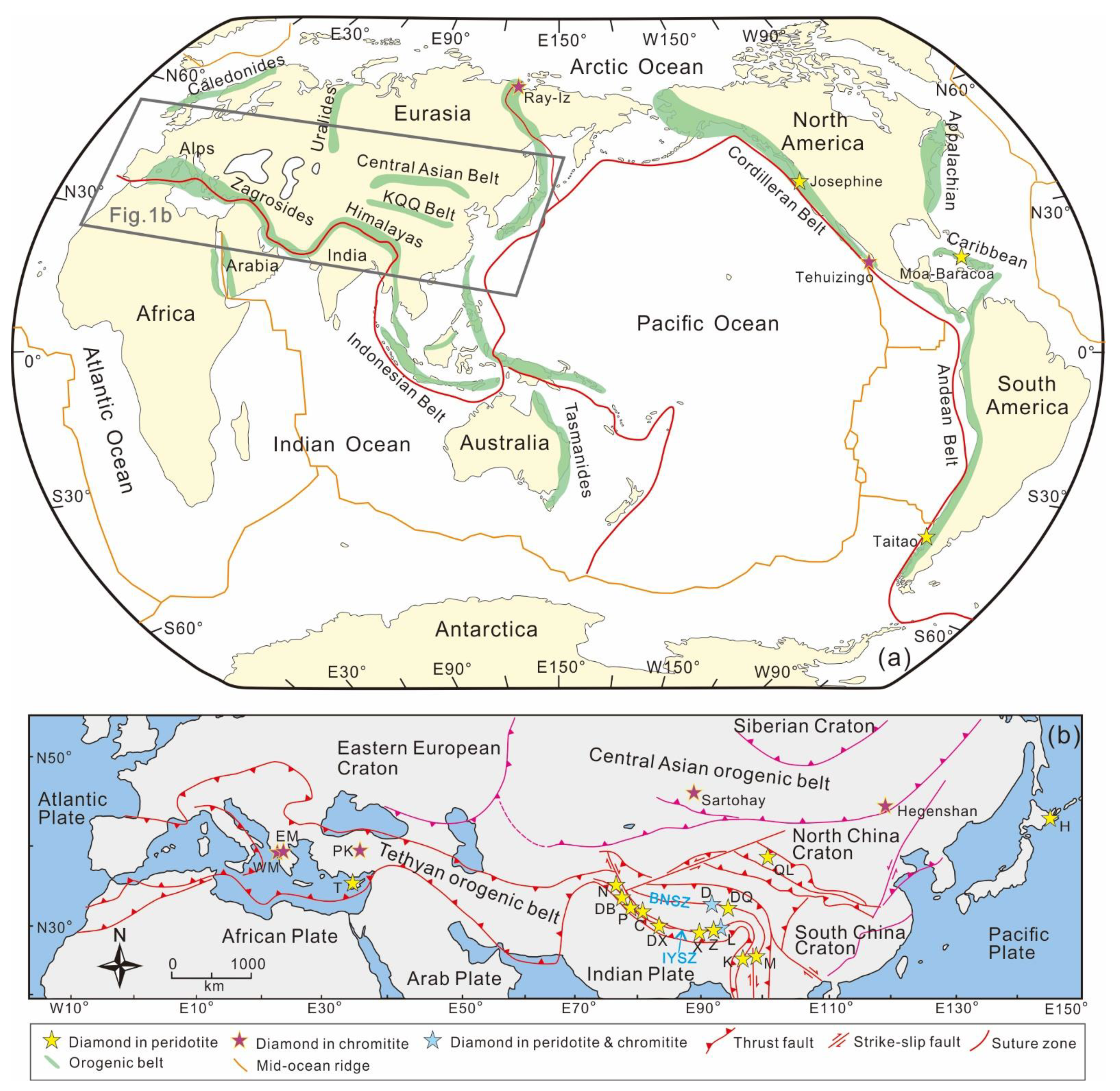
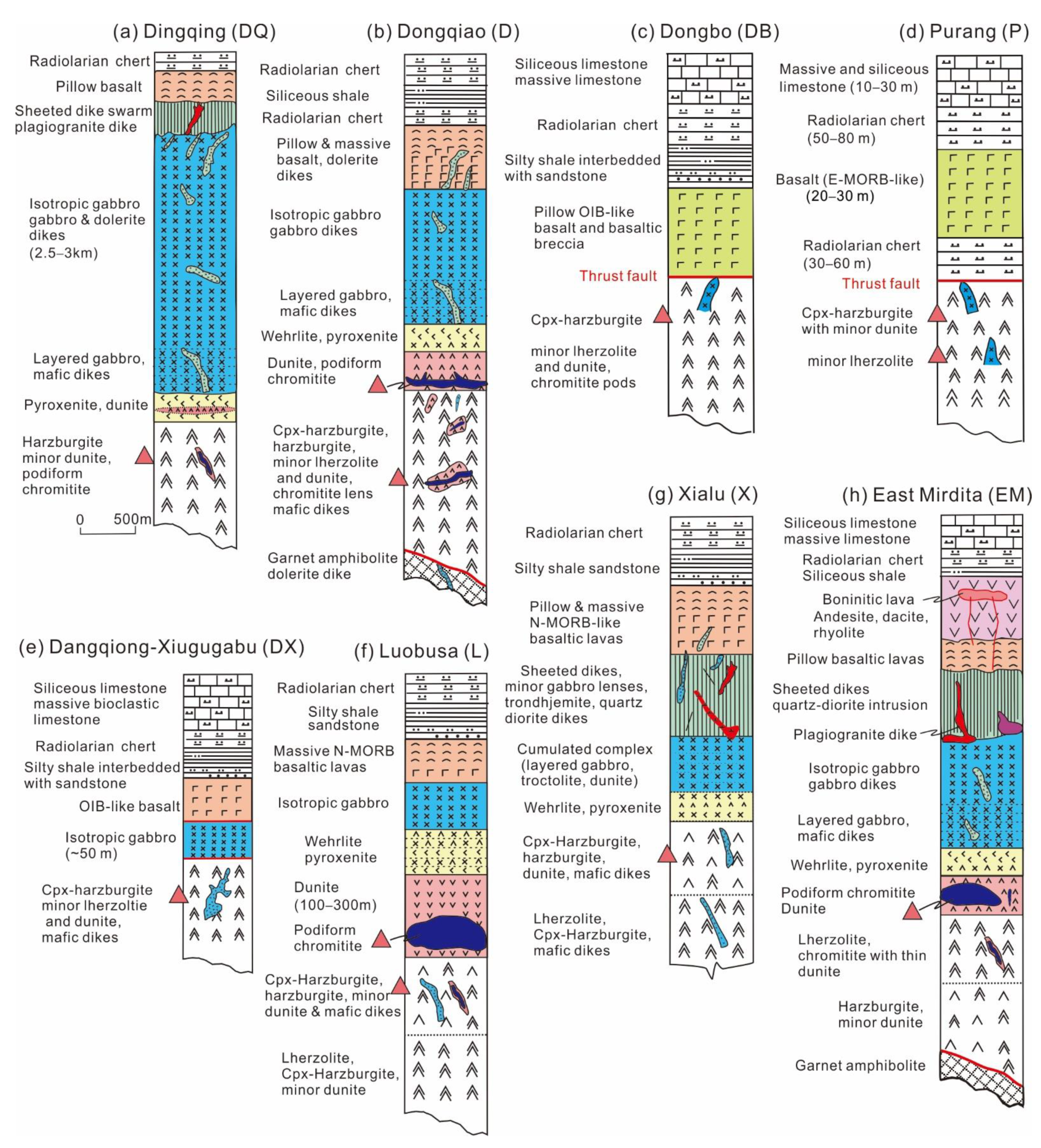
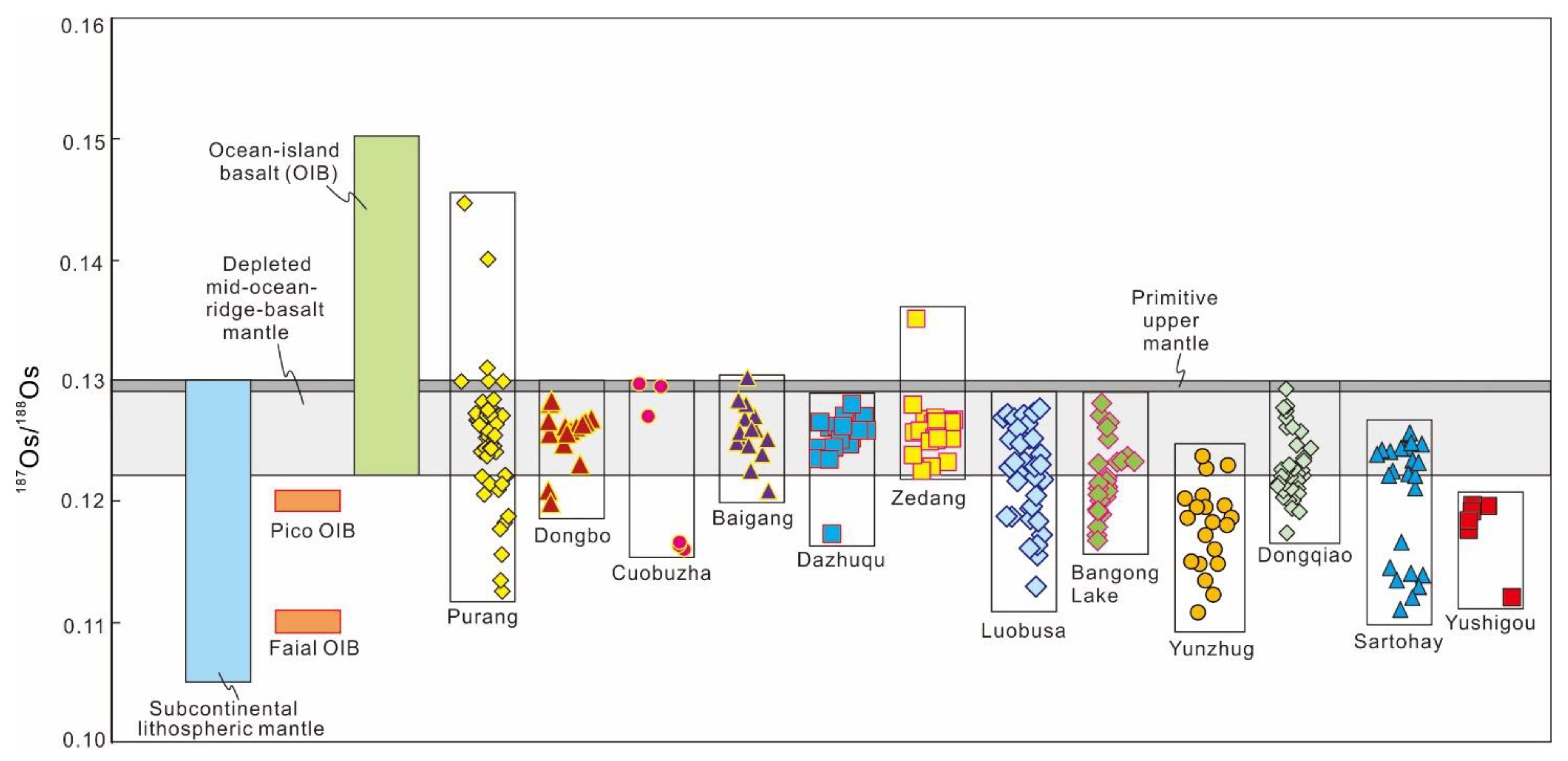

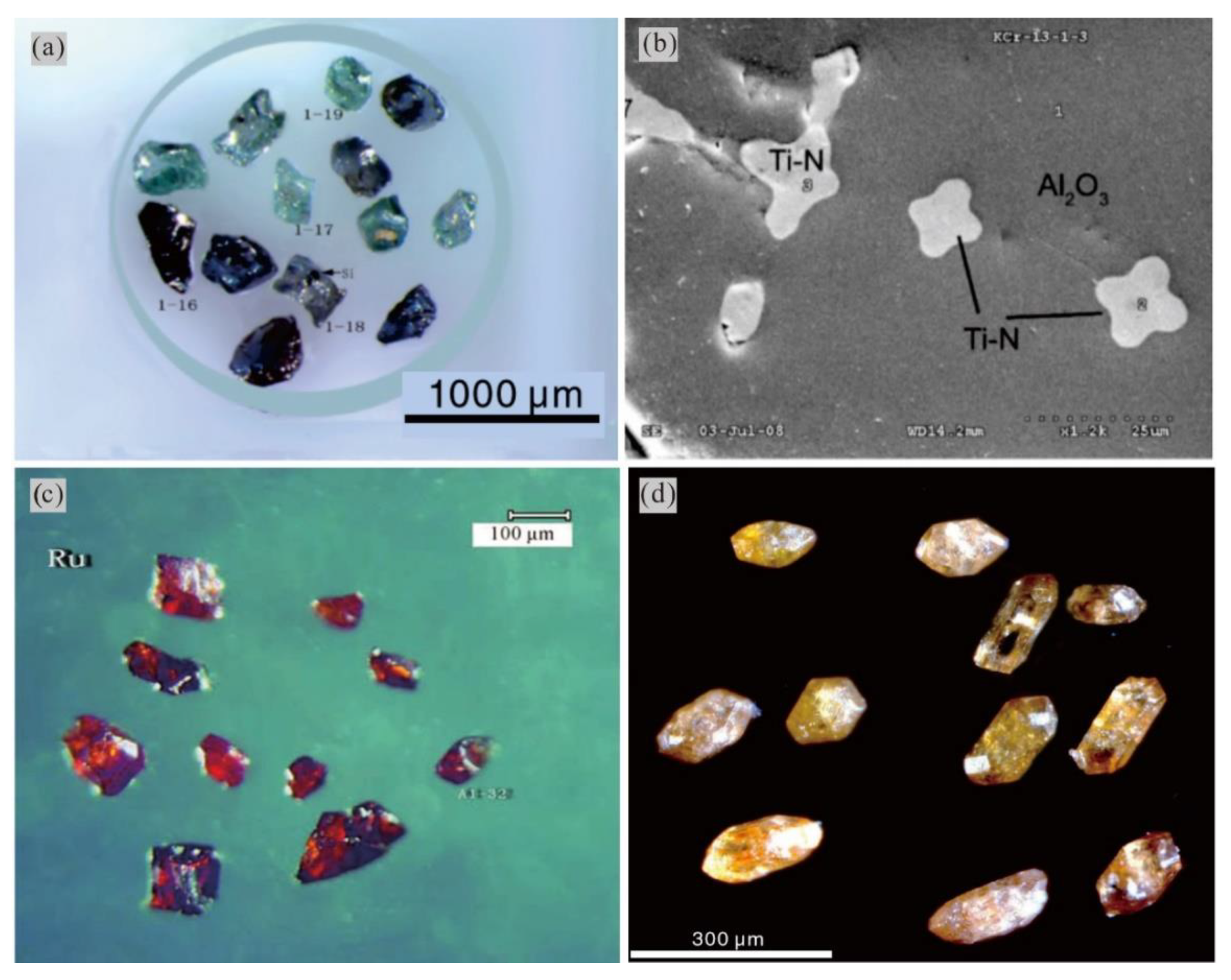
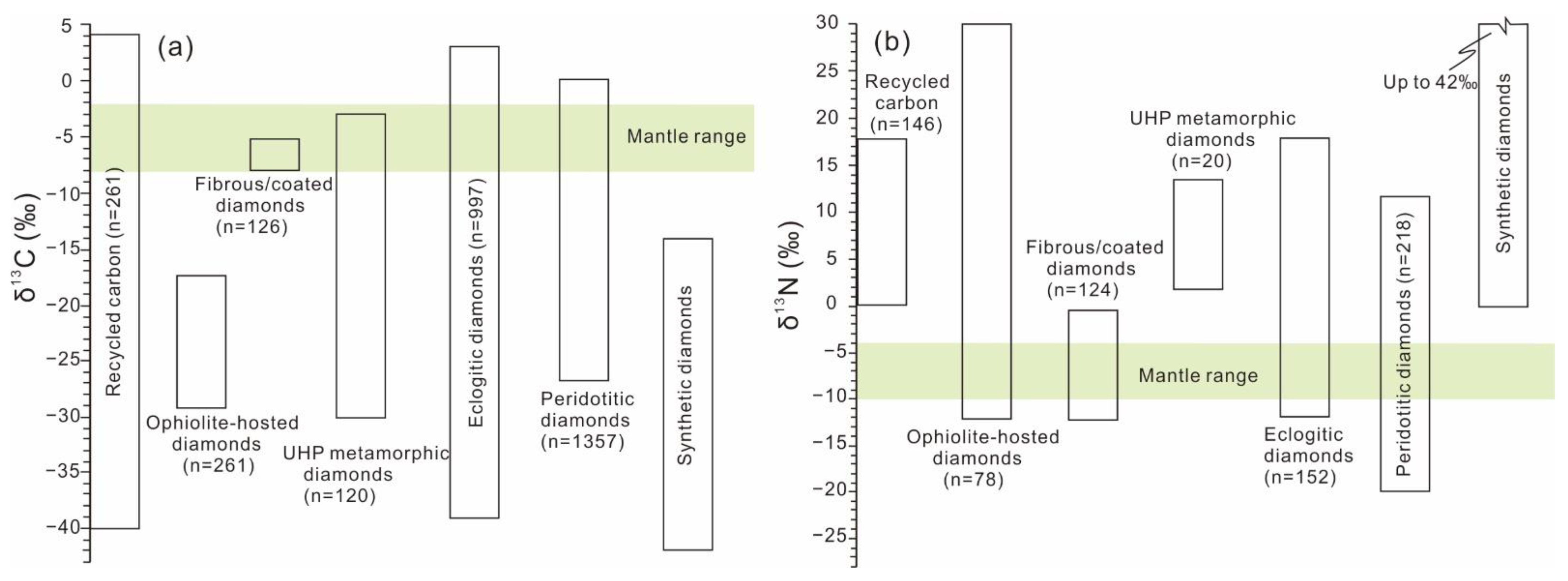
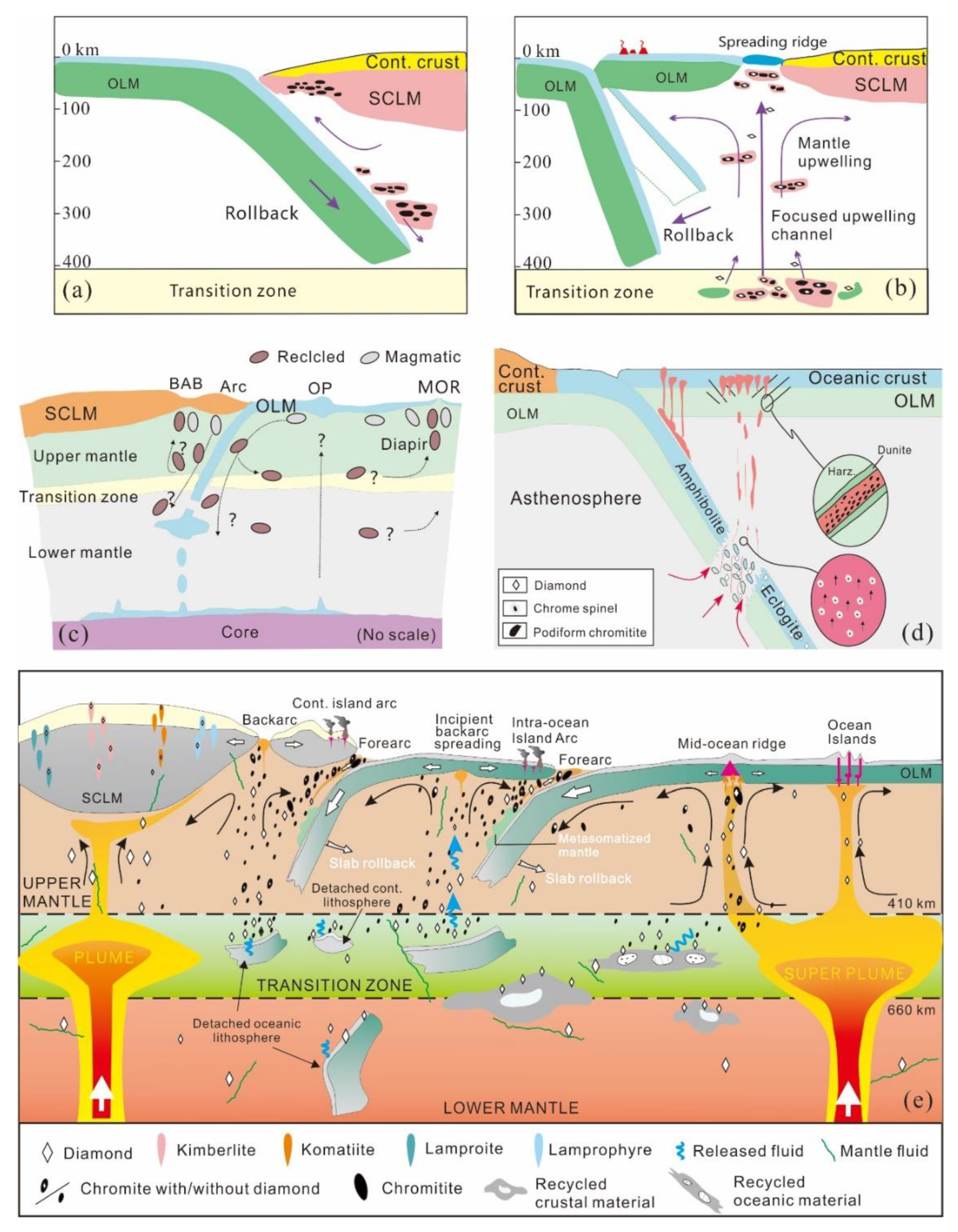
Publisher’s Note: MDPI stays neutral with regard to jurisdictional claims in published maps and institutional affiliations. |
© 2021 by the authors. Licensee MDPI, Basel, Switzerland. This article is an open access article distributed under the terms and conditions of the Creative Commons Attribution (CC BY) license (https://creativecommons.org/licenses/by/4.0/).
Share and Cite
Liu, F.; Lian, D.; Wu, W.; Yang, J. Diamond and Other Exotic Mineral-Bearing Ophiolites on the Globe: A Key to Understand the Discovery of New Minerals and Formation of Ophiolitic Podiform Chromitite. Crystals 2021, 11, 1362. https://doi.org/10.3390/cryst11111362
Liu F, Lian D, Wu W, Yang J. Diamond and Other Exotic Mineral-Bearing Ophiolites on the Globe: A Key to Understand the Discovery of New Minerals and Formation of Ophiolitic Podiform Chromitite. Crystals. 2021; 11(11):1362. https://doi.org/10.3390/cryst11111362
Chicago/Turabian StyleLiu, Fei, Dongyang Lian, Weiwei Wu, and Jingsui Yang. 2021. "Diamond and Other Exotic Mineral-Bearing Ophiolites on the Globe: A Key to Understand the Discovery of New Minerals and Formation of Ophiolitic Podiform Chromitite" Crystals 11, no. 11: 1362. https://doi.org/10.3390/cryst11111362
APA StyleLiu, F., Lian, D., Wu, W., & Yang, J. (2021). Diamond and Other Exotic Mineral-Bearing Ophiolites on the Globe: A Key to Understand the Discovery of New Minerals and Formation of Ophiolitic Podiform Chromitite. Crystals, 11(11), 1362. https://doi.org/10.3390/cryst11111362





